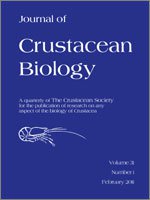We collected postlarvae (PL) and early juveniles of Farfantepenaeus aztecus and F. duorarum < 7.0 mm CL from the Gulf of Mexico and verified their species identity using a multiplex Polymerase Chain Reaction (PCR) assay, which targeted the 16S rRNA mitochondrial gene. We examined young with ≥ 5 dorsal teeth (DT) for differences in morphology and used a General Discriminant Analysis approach and ‘best’ subsets model-building technique to help identify the ‘best’ characters to discriminate taxa and predict species membership. Farfantepenaeus duorarum with ≥ 5 DT and F. aztecus with ≥ 7 DT have spinules on the epigastric and first DT, a character not previously reported for these two species. Differences in antennal scale shape and sixth pleomere length discriminate > 95% of Farfantepenaeus sp. with < 7 – 8 2 rostral teeth. Farfantepenaeus duorarum has an antennal scale with an acutely rounded margin about twice the height of the adjacent lateral spine, and has a sixth pleomere length measurement < 2.5 mm. In F. aztecus, the antennal scale has a more broadly rounded margin with a lateral spine that approaches or exceeds the tip of the scale, and has a sixth pleomere length measurement > 2.5 mm. Species discrimination of Farfantepenaeus sp. with ≥ 7 – 8 2 rostral teeth requires body measurements. Classification models accurately discriminate > 90% of Farfantepenaeus sp. from the western Gulf and increase the reliability of discrimination by > 20% over characters that have been used for species discrimination, some of which are unreliable. The unsatisfactory performance of the models in discriminating Farfantepenaeus sp. from the eastern Gulf is consistent with the possibility of different ecological populations in the eastern and western Gulf that may warrant further study. Integration of molecular taxonomy and comparative morphology, as we did here, can provide insight into the patterns of diversity and ecological and evolutionary principles that encompass fisheries management.
How to translate text using browser tools
1 February 2011
Species Discrimination of Postlarvae and Early Juvenile Brown Shrimp (Farfantepenaeus aztecus) and Pink Shrimp (F. duorarum) (Decapoda: Penaeidae): Coupling Molecular Genetics and Comparative Morphology to Identify Early Life Stages
James G. Ditty,
Jaime R. Alvarado Bremer
ACCESS THE FULL ARTICLE
It is not available for individual sale.
This article is only available to subscribers.
It is not available for individual sale.
It is not available for individual sale.

Journal of Crustacean Biology
Vol. 31 • No. 1
February 2011
Vol. 31 • No. 1
February 2011
Farfantepenaeus
General Discriminant Analysis
Gulf of Mexico
multiplex PCR assay
spinules




